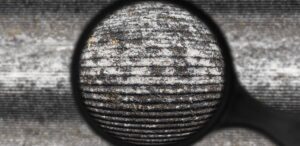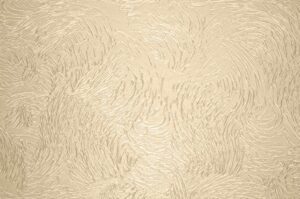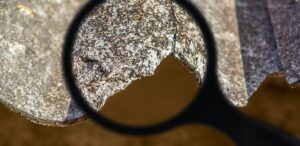“Where is asbestos commonly found in houses?”
That`s a question I am often asked.
Asbestos used to be a popular building material in the UK until being banned in 1999. Due to this, asbestos can be found in any building that was built or renovated before the turn of the millennium – in industrial, commercial, and domestic properties alike.
In terms of domestic properties, asbestos can be found throughout the home, in both interior and exterior elements such as the attic, heating system, walls, floors, ceilings, roof, and more.
But how do you identify asbestos? The key is to understand what types of asbestos can be found in the home, and where exactly each example might be found.
Here is where asbestos is commonly found in domestic properties, and how you might differentiate between asbestos and modern building materials.
Decorative and protective coatings
Asbestos protective coatings were typically sprayed onto surfaces such as steel work and underneath roofs to protect against fire. If they haven’t been painted over, they are rough, with a grey or white hue.
Sprayed asbestos coatings have been used as a decorative element, too, to give ceilings and walls a textured finish.
Asbestos can also be found as a sprayed insulated coating on some boilers.
Loose fill insulation
Loose fill insulation is characteristically a bluey-grey or white colour, and loose in texture. It was commonly used as insulation in cavity walls, underneath floors, and under the eaves of a roof.
Around boiler and pipes
Asbestos was also used as insulation around boilers, pipes, and other aspects of the heating system of a house. You might see this referred to as ‘lagging’, and it can be spotted by looking for a coating that is delicate and fibrous.
Be careful not to disturb it, however, as it can disintegrate into small particles quite easily. Due to this, asbestos lagging in particular must only be interacted with by fully trained professionals using protective clothing.
AIB
AIB stands for asbestos insulating board, which could be used in a variety of different residential applications. The complication with AIB is that it is quite difficult to spot the difference between it and its modern alternative – which is why experts like us here at Asbestos 365 are here to help.
AIB was used in several interior elements, including ceiling tiles, floor tiles, partition walls, bath panels, airing cupboards, and additionally installed behind fuse boxes, around boilers, and behind fireplaces.
Both indoor and outdoor window panels could be made using AIB, as well as exterior roofline products like soffits and guttering.
Textiles and composites
Textiles made from asbestos have been used in fuse boxes and roofing felt – but also in fire blankets, if you are in a rented domestic property. Composites made from asbestos fibres have been known to be used for plastic-like products like window sills, bath panels, and toilet seats.
Asbestos textiles and composites are another example of material where the asbestos product often cannot be differentiated from their modern equivalents without specialist training.
Asbestos cement
Asbestos cement is pretty much exactly as it sounds – it is cement made with asbestos, which is usually grey coloured, just like modern cement. The asbestos cement could be poured, compressed, and set hard to create a wide range of products.
In residential settings, water tanks, downpipes, flues, wall cladding, roof panels, guttering, and even entire roofs can be made from asbestos cement.
Floor tiles
Asbestos was an extremely popular choice for floor tiles. Asbestos floor tiles look almost identical to modern vinyl floor tiles, so will need to be inspected and tested by a professional to determine the material at hand.
Asbestos floor tiles might be hidden in your home, and so you might not even know they exist! You might only spot them when pulling up your carpet during renovations.
Asbestos floor tiles do not pose a risk to health unless you are drilling into the floor or attempting to pull up these newly discovered tiles, so it is important to be vigilant when installing new flooring.
How do you identify asbestos, and what do you do once you have found it?
The use of asbestos was banned in the UK in 1999 due to health hazards that it poses. Though it does not always inherently damage one’s health, it becomes more dangerous once disturbed. Asbestos is a fibrous silicate mineral, which means that, when damaged or disturbed, it can disintegrate into small particles. If this is breathed in or ingested, it can potentially cause serious (or even fatal) health issues over time.
With this in mind, if you have identified asbestos within your home, suspect its presence, or simply want to double check, it’s time to call in the experts. Discover our asbestos surveyors in London today, and let our professionals inspect your domestic property for potential asbestos for you.









